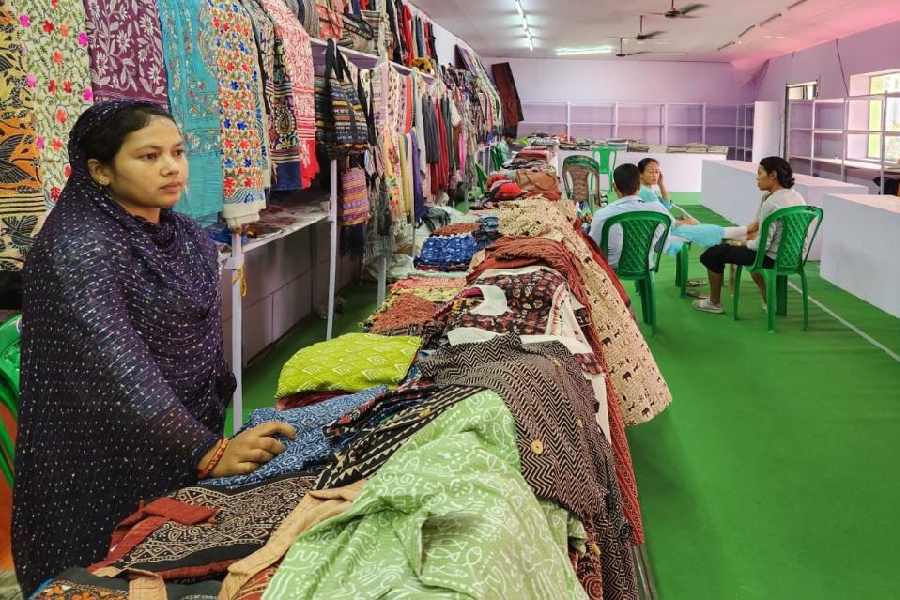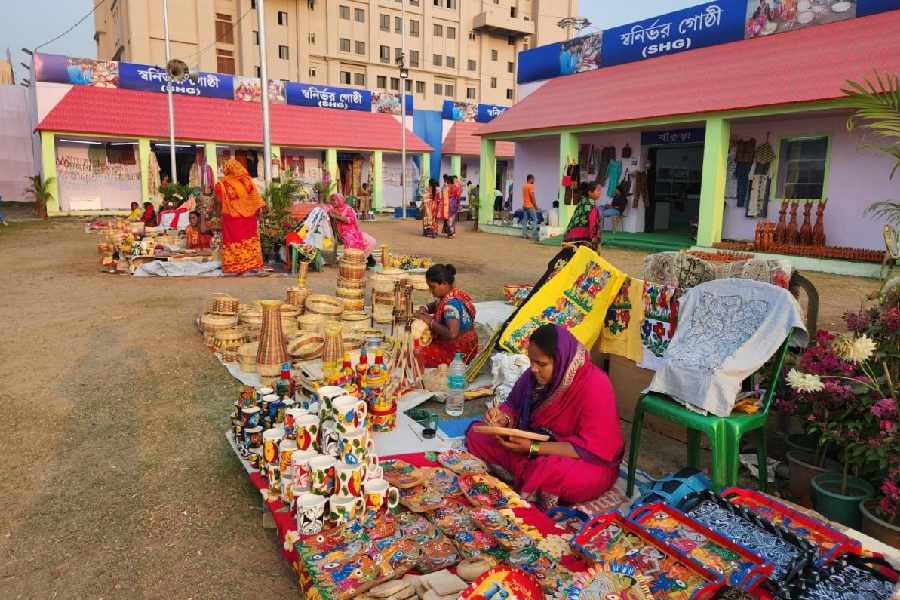A new fair is on outside Eco Park but it’s rather sleepy and has a shifting format that has left customers confused and vendors exhausted.
Hastashilpa, Tantbastra o Swarojgar Mela 2024 is a three-week fair from February 22 to March 14 but the artisans there are changing every week.
In the first week, the stalls were occupied by artisans from Cooch Behar, Alipurduar, Jalpaiguri, Kalimpong, Darjeeling, North and South Dinajpur, Malda and Murshidabad. They left after February 28 and in came craftsmen from Birbhum, East and West Burdwan, Jhargram, Bankura, Purulia, East and West Midnapore.
If you visit the fair now you’ll find the final lot that has come from Calcutta, Howrah, Hooghly, North and South 24-Parganas and Nadia. They set up shop on March 7 and will stay till March 14.
The fair is being organised by the micro, small and medium enterprises and textile department in association with the panchayat and rural development department’s Anandadhara (National Rural Livelihood Mission). Money has been spent and effort has been made but the format hasn’t taken off, say the artisans.

Half of this pavilion had been vacated by artisans due to poor sales, as per neighbours Brinda Sarkar
Flop format
The fair begins at 1pm but even at 2.30 on Monday, several artisans were fast asleep on their pavilion floors since no customers were in sight.
“This shifting format is confusing. Customers are used to three-week-long fairs like Hasta Shilpo Mela where they come a first time to check out stalls and return towards the end of the fair having decided what to buy. But at this fair, when customers return we’ll be gone,” said Rina Khatun, who has brought saris, kurtis and bed sheets from Santiniketan.
Sanuyar Chitrakar of West Midnapore said he knew the format would flop when he first heard of it but still came as the government was making an effort to help them. “Our stalls, lodging and transport are free but we still have to buy our own food. Sale is so poor that we are just about covering our food expenses here,” Sanuyar said, shaking his head, before returning to painting a wooden tray.
“This fair has been a waste of time. I could have spent this week at home building stocks for next season’s fairs. Here, neither am I able to work properly nor are there any customers,” said the patachitra artiste.
At Rina’s pavilion, one of the two sides had gone empty by the fifth day. “Many artisans have gone back as they weren’t earning enough to even cover food expenses. Most of us are not achieving bouni (first sale of the day),” she said. The sellers from Kalimpong at her pavilion had placed their chairs in a circle and were chatting to kill time in absence of customers.
Publicity lacking
With the new format, there is monotony in the items on offer. Other state fairs have variety but since only some districts are being showcased at a time here, there’s an overdose of, say, patachitra or kantha.
Rehana Chitrakar of West Midnapore could not believe that this was the same ground where Hasto Shilpa Mela takes places. “We’re struggling to get even a tenth of the footfall at that event. This is a new fair and they should have publicised it aggressively,” said the patachitra artiste. “As for artisans, most of our expenses may be covered by the state but we are exhausted carrying so many wares in and out within a week, especially when it translates to negligible sales.”
Kunal Nandi of Santiniketan felt it was a lost opportunity. “This was the last fair before summer but customers didn’t even get to know of it. We went three days without bouni and made Rs 2,000 the next day. Many artisans left,” said the textile artistan. “We appreciate the effort of the government but marketing was lacking.”
Sk. Rafikul of Birbhum was frustrated with the footfall too. “Ninety nine per cent of us will refuse to return to a fair of this format if they try to repeat it next year,” said the artisan who had to take almost his entire lot of kantha-stitched items back home.
Fair fatigue
An official of the organising committee cited a number of challenges that this fair had to face head-on.
“The artisans here are the same ones who came for Saras, Sabala and Hasta Shilpa Mela every few weeks all winter. How much of the same products can visitors buy or even browse?” asked the official, asking not to be named.
He blamed poor footfall on the ongoing examinations that are keeping students and especially mothers away. “It’s unfair to say we haven’t spent on advertising. We are the same people behind the immensely successful Hasta Shilpa Mela and are putting up the same banners and hoardings up now. It’s just that this is a new fair that no one knows about,” he said. “There’s also the hot and happening Bidhannagar Mela (Utsav) to compete with.”
Hasta Shipa Mela gets about 7-8,000 artisans, he said, whereas at this fair there were about 1,800. As for artisans leaving mid-way he said, at least officially, they had been handed applications citing emergencies like illnesses of family members back home. Asked if the fair would have done better had all artisans been allowed to stay for three weeks, he did not agree.
“The artisans would have been worse off that way. These are people who earned in lakhs at Hasto Shilpa Mela. They would not be able to stay for so long at a fair where they are swatting flies. It’s better that they cut losses and pack up in a week,” he said.
